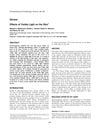Epidermal Pigmentation in the Human Lineage as an Adaptation to Ultraviolet Radiation
October 2013
in “
Journal of Human Evolution/Journal of human evolution
”
TLDR Forensic DNA Phenotyping can help predict physical traits from crime scene DNA to identify suspects.
Elias and Williams hypothesized that epidermal pigmentation in humans evolved primarily to enhance the barrier functions of the stratum corneum (SC) under conditions of high environmental aridity. They proposed that darkly pigmented skin, which contains more acidic, eumelanin-containing melanosomes, offers a more competent permeability barrier compared to lightly pigmented skin. This adaptation was suggested to be driven by the need to protect against high transepidermal water loss (TEWL) and ultraviolet radiation (UVR). The study highlighted that skin pigmentation is most strongly correlated with UVR levels rather than aridity, with 86% of the variation in human skin reflectance explained by UVR exposure.
